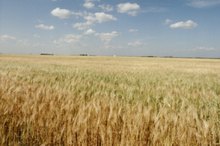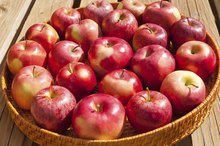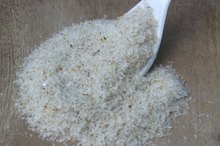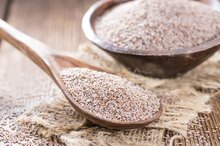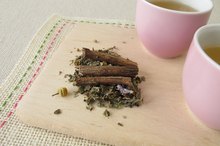What does fact checked mean?
At Healthfully, we strive to deliver objective content that is accurate and up-to-date. Our team periodically reviews articles in order to ensure content quality. The sources cited below consist of evidence from peer-reviewed journals, prominent medical organizations, academic associations, and government data.
The information contained on this site is for informational purposes only, and should not be used as a substitute for the advice of a professional health care provider. Please check with the appropriate physician regarding health questions and concerns. Although we strive to deliver accurate and up-to-date information, no guarantee to that effect is made.
Advantages & Disadvantages of Natural Fibers
Natural fibers are most densely found in the edible skins of certain foods. Natural fibers are referred to as dietary fiber that consists of the bulk of food that your body cannot absorb. Soluble fiber dissolves in water and forms a gel and can be found in flaxseed, apple skins, carrots, barley, beans, peas, oats, citrus and psyllium. Insoluble fibers do not dissolve in water and are part of the elimination process and come from nuts, whole-wheat flour, wheat bran and many vegetables.
Increases Heart Health
According to the American Dietetic Association, you can reduce your risk of heart disease if you consume an adequate amount of fiber. Fiber reduces the cholesterol levels in your blood. This is done with eating soluble fiber that lowers low-density lipoprotein, or “LDL” or “bad” cholesterol. Fiber also reduces hypertension and inflammation to prevent heart attacks. The National Academy of Sciences’ Institute of Medicine recommends fiber intakes of 38 g for men and 25 g for women under age 50 and 30 g for men and 21 g for women age 51 and older.
- According to the American Dietetic Association, you can reduce your risk of heart disease if you consume an adequate amount of fiber.
Regulates Blood Sugar Levels
Compare Soluble Fiber in Lentils & Barley
Learn More
Insoluble fiber is helpful in reducing the risk of acquiring type 2 diabetes. Soluble fiber assists in treating diabetes. It slows down the absorption rate of sugar, which keeps insulin levels balanced.
Weight Loss
Foods high in fiber usually contain less calories per volume of food as refined foods or foods without fiber. Because high-fiber foods contain bulk, it takes more time to chew. This allows more time for your stomach to realize that it is satisfied, and may help prevent you from overeating. Also, because of the bulk, high-fiber foods are more massive and fill your appetite for a longer amount of time than refined carbohydrates like white breads and pastas. This also may mean that you can afford to eat healthier by buying less, but higher quality, fibrous foods.
- Foods high in fiber usually contain less calories per volume of food as refined foods or foods without fiber.
- Also, because of the bulk, high-fiber foods are more massive and fill your appetite for a longer amount of time than refined carbohydrates like white breads and pastas.
Intestine Health
Can You Eat Very High-Fiber Foods and Still Be Constipated?
Learn More
Fiber makes your solid waste easier to eliminate because it enlarges and softens it, thereby reducing constipation. Dietary fiber has been known to reduce symptoms of irritable bowel syndrome. Because fiber adds bulk to your stool, it cleans your intestines.
Prevents Colon Disease and Hemorrhoids
According to the CNN Health website, a high-fiber diet can reduce your risk of hemorrhoids, diverticular disease and other colon diseases.
Too Much Fiber
There is only one minor disadvantage from eating dietary fiber. If you eat too much at one time, it could cause discomfort and constipation. Constipation usually occurs if you also do not drink enough liquids with a fiber supplement. Psyllium husks and whole flaxseed are types of fiber to be most careful with over-consuming.
- There is only one minor disadvantage from eating dietary fiber.
- Constipation usually occurs if you also do not drink enough liquids with a fiber supplement.
Related Articles
References
- Dahl WJ, Stewart ML. Position of the Academy of Nutrition and Dietetics: Health Implications of Dietary Fiber. J Acad Nutr Diet. 2015 Nov;115(11):1861-70. doi: 10.1016/j.jand.2015.09.003.
- Francesca De Filippis, et.al. High-level adherence to a Mediterranean diet beneficially impacts the gut microbiota and associated metabolome. Gut, 2015; gutjnl-2015-309957 DOI: 10.1136/gutjnl-2015-309957
- Harvard School of Public Health. http://www.hsph.harvard.edu/nutritionsource/carbohydrates/fiber/
- University of Maryland Medical Center. http://umm.edu/health/medical/altmed/supplement/fiber
- USDA.http://www.ers.usda.gov/topics/
Writer Bio
Diana Gamble's health-oriented articles have been published in magazines such as "The Natural Journal" since 2007. She earned certifications for massage therapy and nutritional consulting from the North Carolina School of Holistic Medicine. She graduated from the University of North Carolina-Asheville with a Bachelor of Arts in literature.
